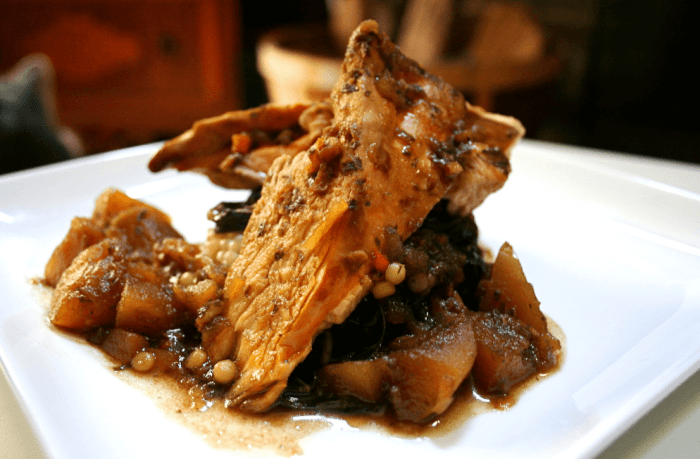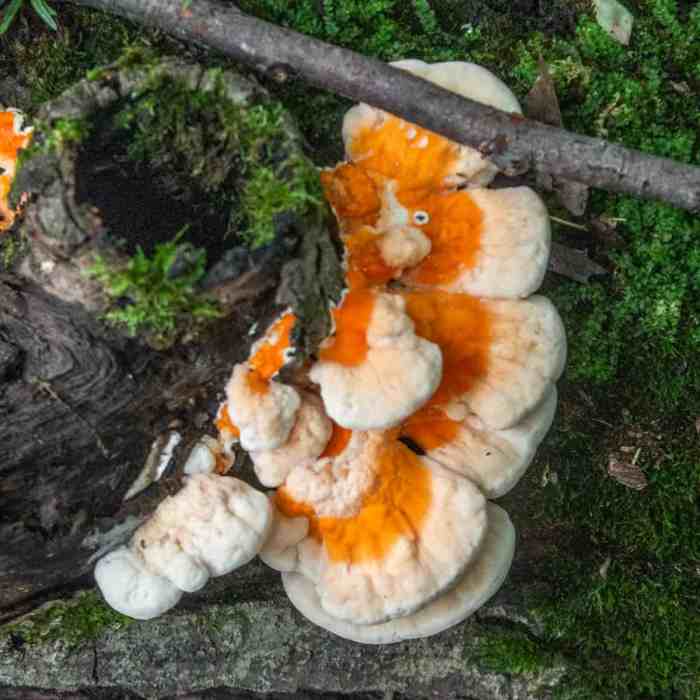
Embark on a culinary adventure with the chicken of the woods recipe, a delectable wild mushroom that tantalizes taste buds and offers a glimpse into the wonders of nature’s pantry.
This versatile fungus boasts a rich history and nutritional value, making it a cherished ingredient in various cuisines worldwide. Its distinct flavor and meaty texture have earned it a special place in the hearts of mushroom enthusiasts and adventurous foodies alike.
Introduction to Chicken of the Woods

Chicken of the Woods ( Laetiporus sulphureus) is a vibrant, edible mushroom that is gaining popularity among mushroom enthusiasts. This fungus is characterized by its bright orange to yellow color, resembling the plumage of a chicken. The mushroom is found in various parts of the world, primarily growing on oak trees.
Chicken of the Woods is known for its delicious flavor, described as having a meaty, chicken-like texture and a slightly peppery taste. It is a versatile ingredient that can be cooked in various ways, including sautéing, grilling, and frying.
Nutritional Value
Chicken of the Woods is not only delicious but also packed with nutrients. It is a good source of protein, fiber, and essential vitamins and minerals. The mushroom contains antioxidants that help protect the body from damage caused by free radicals.
Selecting and Preparing Chicken of the Woods

Identifying and selecting the right Chicken of the Woods is crucial for a successful culinary experience. This guide will provide you with the necessary knowledge to choose the best specimens and prepare them properly for cooking. Additionally, tips for preserving and storing Chicken of the Woods will ensure that you can enjoy its deliciousness for an extended period.
Identifying and Selecting
- Color:Look for vibrant orange or yellow coloration, indicating freshness and edibility.
- Texture:The mushroom should be firm and springy to the touch, avoiding any slimy or mushy specimens.
- Size:Choose medium-sized mushrooms, as larger ones may be tough and woody.
- Avoidation:Steer clear of any mushrooms with signs of bruising, discoloration, or insect damage.
Cleaning and Preparing
- Gently Brush:Use a soft brush to remove any debris or dirt from the mushroom’s surface.
- Cut Away Tough Parts:Remove any woody or tough portions from the mushroom’s base.
- Slice or Shred:Cut the mushroom into slices or shred it for easier cooking and consumption.
Preserving and Storing
- Refrigeration:Store cleaned and sliced Chicken of the Woods in an airtight container in the refrigerator for up to 5 days.
- Freezing:For longer storage, freeze the mushroom in airtight containers for up to 6 months.
- Drying:Dehydrate the mushroom in a food dehydrator or oven at low temperatures for extended shelf life.
Cooking Techniques for Chicken of the Woods

Chicken of the Woods is a versatile mushroom that can be cooked in various ways, each method bringing out its unique flavors and textures. From sautéing to grilling and roasting, let’s explore the best cooking techniques for this delectable treat.
Before cooking, it’s crucial to clean the mushrooms thoroughly. Remove any debris or dirt by gently brushing or rinsing them. Cut them into bite-sized pieces to ensure even cooking.
Sautéing
Sautéing is a quick and easy way to cook Chicken of the Woods. Heat a pan over medium heat, add a drizzle of olive oil or butter, and sauté the mushrooms for 5-7 minutes, stirring occasionally. Season with salt and pepper to taste.
Grilling
Grilling imparts a smoky flavor to Chicken of the Woods. Preheat your grill to medium heat, brush the mushrooms with olive oil, and grill for 8-10 minutes, flipping once. Baste with a marinade or sauce for extra flavor.
Roasting
Roasting is a great method for cooking larger quantities of Chicken of the Woods. Preheat your oven to 400°F (200°C), toss the mushrooms with olive oil, salt, and pepper, and roast for 15-20 minutes, or until tender and slightly browned.
Comparison of Cooking Methods
| Method | Advantages | Disadvantages |
|---|---|---|
| Sautéing | Quick and easy, retains moisture | Can be mushy if overcooked |
| Grilling | Smoky flavor, retains texture | Requires attention to prevent burning |
| Roasting | Even cooking, caramelizes edges | Can dry out if overcooked |
Flavor Pairings and Accompaniments: Chicken Of The Woods Recipe

Chicken of the Woods is a versatile mushroom that pairs well with various herbs, spices, and ingredients. Its earthy, umami flavor makes it a great addition to both savory and sweet dishes.
When selecting herbs and spices, consider the dish you are preparing. For example, rosemary, thyme, and sage complement the mushroom’s earthy notes in savory dishes. For sweeter dishes, cinnamon, nutmeg, and allspice add a touch of warmth and complexity.
Side Dishes and Accompaniments
Chicken of the Woods can be paired with various side dishes and accompaniments to enhance its flavor. Roasted vegetables, such as carrots, onions, and bell peppers, bring out the mushroom’s natural sweetness. Creamy sauces, like béchamel or mushroom cream sauce, add a richness and depth of flavor.
Polenta or mashed potatoes provide a hearty base for the mushroom.
Culinary Uses, Chicken of the woods recipe
Chicken of the Woods is used in various cuisines worldwide. In North America, it is often sautéed, roasted, or fried. In Europe, it is frequently used in soups, stews, and sauces. In Asia, it is commonly pickled or added to stir-fries and hot pots.
Health Benefits and Considerations

Consuming Chicken of the Woods is associated with several potential health benefits due to its rich nutritional profile. These benefits include:
Nutritional Profile
- High in fiber: Aids in digestion, promotes satiety, and supports gut health.
- Rich in vitamins and minerals: Contains vitamins B1, B2, B3, D2, potassium, and phosphorus.
- Antioxidant properties: May help protect cells from damage caused by free radicals.
- Immune-boosting compounds: Beta-glucans and other polysaccharides support immune function.
Precautions and Considerations
While generally safe for consumption, there are a few precautions to consider:
- Proper identification: It is crucial to ensure accurate identification of Chicken of the Woods to avoid confusion with similar but potentially toxic species.
- Digestibility: Some individuals may experience digestive discomfort after consuming Chicken of the Woods due to its high fiber content.
- Allergic reactions: Although rare, allergic reactions to mushrooms, including Chicken of the Woods, are possible.
Outcome Summary
As we conclude our exploration of the chicken of the woods recipe, we leave you with a newfound appreciation for this extraordinary mushroom. Whether you’re a seasoned chef or a culinary novice, we encourage you to experiment with this versatile ingredient and create dishes that will delight your palate and nourish your body.
Questions and Answers
What are the health benefits of chicken of the woods?
Chicken of the woods is a good source of protein, fiber, and antioxidants, making it a nutritious addition to any diet.
How can I identify chicken of the woods?
Chicken of the woods typically has a bright orange color and a velvety texture. It often grows in clusters on the sides of trees.
What are some tips for cooking chicken of the woods?
Chicken of the woods can be cooked in a variety of ways, including sautéing, grilling, and roasting. It pairs well with herbs, spices, and other vegetables.





